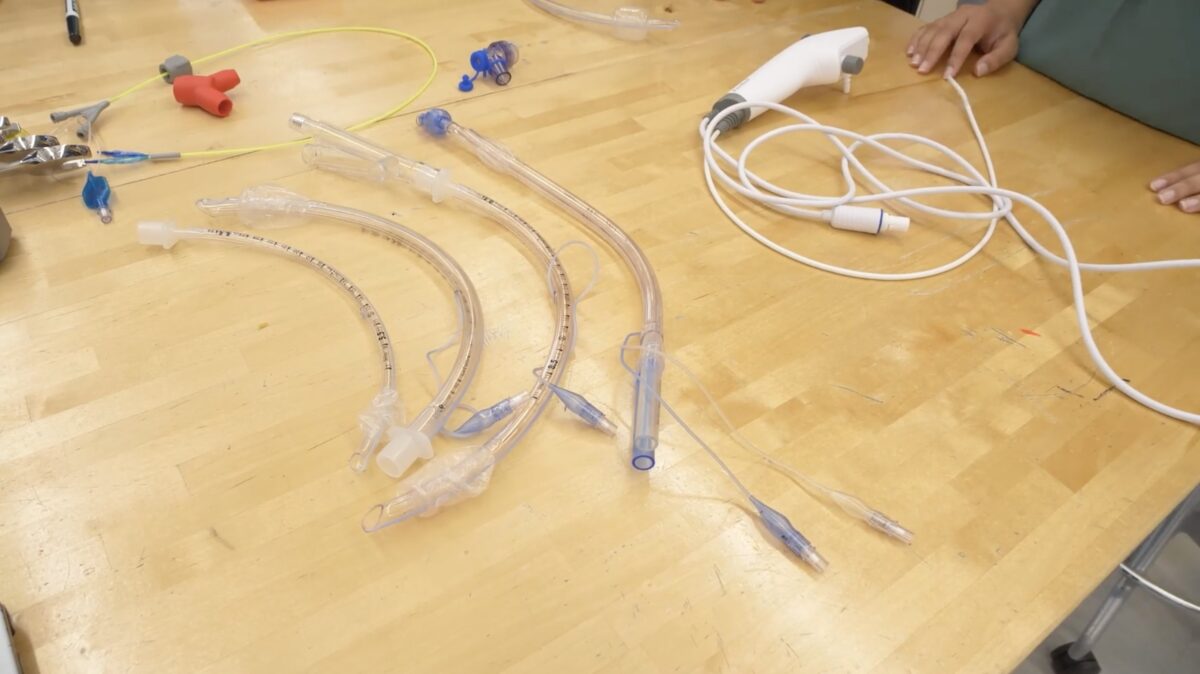The one-lung ventilation (OLV) procedure, as described by the National Institute for Health, involves doctors deliberately ventilating one lung while allowing the other to rest or collapse.
A group of Johns Hopkins University (JHU) students and alumni have recently developed a new product aimed at enhancing the OLV process to reduce the risk of ventilator-induced lung injuries in patients. It’s called the Bronchosleeve, and the team works under the umbrella of OnPoint Ventilation. Clinical cofounders Dr. Brijen L. Joshi and Dr. Viachaslau Barodka were also instrumental in the project’s development.
Sneha Batheja started the Bronchosleeve team during her time as a JHU student, via the Department of Biomedical Engineering’s Undergraduate Design Team program. She earned her bachelor’s and master’s degrees in biomedical engineering from the university last spring, supplemented by a minor in entrepreneurship and management. She told Technical.ly that the OLV procedure has been due for innovation since its origins decades ago.
“This is a space that hasn’t seen significant innovation in decades, if not half a century,” she said. “To delve deeper into the specifics, the double lumen tube … was originally designed based on the anatomy of a middle-aged Caucasian male. However, most patients undergoing cardiothoracic surgery don’t necessarily fall into that category.”
Batheja teamed up with fellow biomedical students Bucky Bryner, Charlie Almoney, Ria Jha, Arijit Nukala, Nina Nair, Krisha Thakur and Alex Gorham to work on a prototype that they hoped would have better results than the commonly used double lumen tube. Nair said that while the team has to keep a lot of Bronchosleeve details under wraps as it files a patent, its device ultimately addresses several issues that arise with current interventions.
“[The double lumen tube is] really bulky, and physicians have to use a lot of force to basically jam it down people’s throats,” Nair said. “So our device has essentially solved the issue of airway trauma by reducing the size of the lumen. But there are other devices, like the bronchial blocker, which don’t allow you to visualize the length [of the] lung or selectively ventilate either lungs. Basically, by optimizing the lumen size of our device, and [using] different inflation mechanisms, we can visualize the lung throughout cardiothoracic procedure and we can selectively ventilate either.”
“The device itself is just a single catheter, there’s a lumen which goes through it,” Nair added. “And at the distal end of the device, there’s an inflation mechanism, which basically allows you to isolate either of the bronchi below.”
Thakur said that the device can benefit a multitude of stakeholders throughout any given hospital system, ranging from the individual to the corporate levels.

“Some of the complications with current devices lead to extended patient stay and a lot of time and money spent by these [hospital] systems, which we’re helping as well,” Thakur said. “Other stakeholders include payors. And then, most importantly, obviously, the patients, whose quality of care after these procedures — as well as their health — is going to be improved.”
Five members of the OnPoint Ventilation team will present Bronchosleeve to judges from both The National Inventors Hall of Fame and the United States Patent and Trademark Office (USPTO) during the 2023 Collegiate Inventors Competition from Oct. 24-25. The event will take place at the USPTO headquarters in Alexandria, Virginia, and offer the team the chance to win $10,000.
This potential prize money would, if won, come on top of a $50,000 one from the Schulze Entrepreneurship Challenge that the team earned last spring. Batheja added that the team has also been supported by the JHU Department of Anesthesiology and Critical Care Medicine and other university-affiliated entities, bringing total funding to over $100,000.
“That funding goes towards a few things, one being actual product R&D — which is basically us going in, using OR equipment and actually testing our device and iterating on it,” Batheja said. “One of the other really hefty costs is the actual prototyping efforts. … The dimensions of our device are really key to it working and working well, and to get a device produced with the right size, right dimensions and the small level of granularity and specificity that we need has been really challenging. And so we’ve actually outsourced some of our prototyping efforts to make sure we get a fully functioning prototype that can be tested on actual patients, or cadavers.”
The Bronchosleeve team, which is roughly 80% women, bucks a trend of underrepresentation of women in the biotech field. Batheja tied the team’s composition to its desire to make the Bronchosleeve as accessible as possible — especially given the marginalized populations impacted by lung conditions.
We think of ourselves as not only a diverse team, but just a team of students that are all really passionate about creating change in a field that hasn’t been changed in 50 to 100 years,” she said. “I think [it’s important to make] sure that we’re framing our group project and creating a device that’s not only accessible to people at different income levels, but also equitable to all the people that this problem affects. Because right now, it does disproportionately affect women. It disproportionately affects people of color. It disproportionately affects the elderly.”







